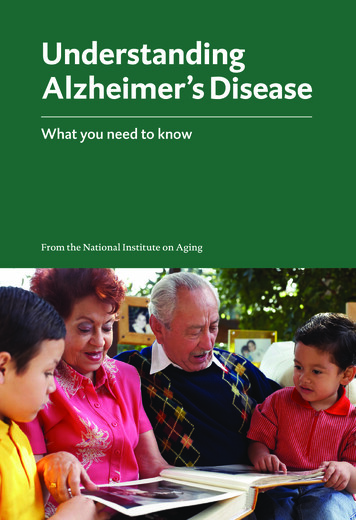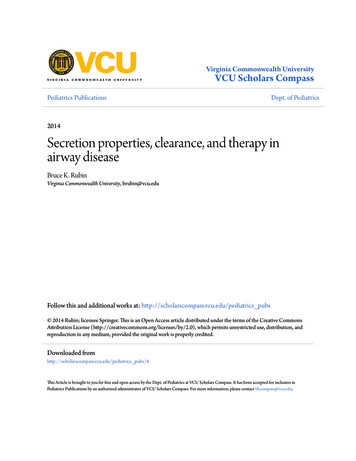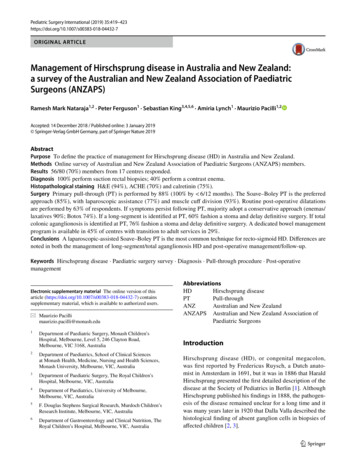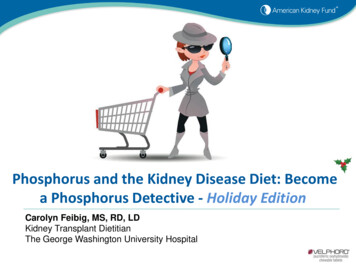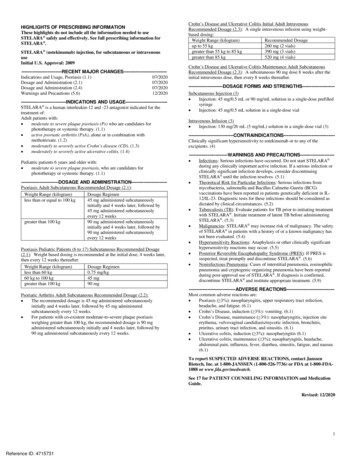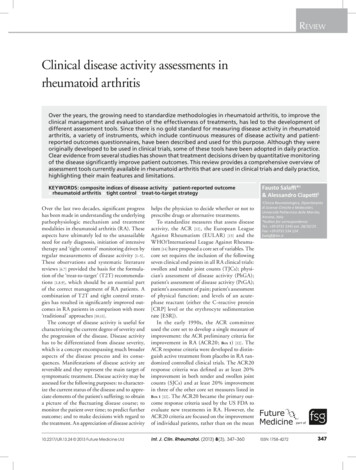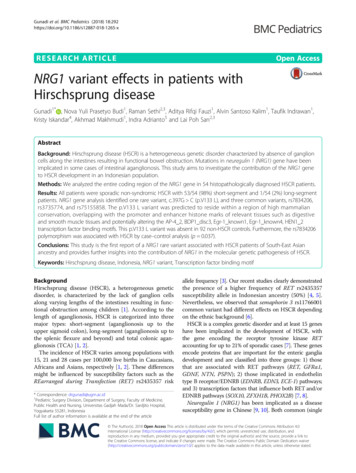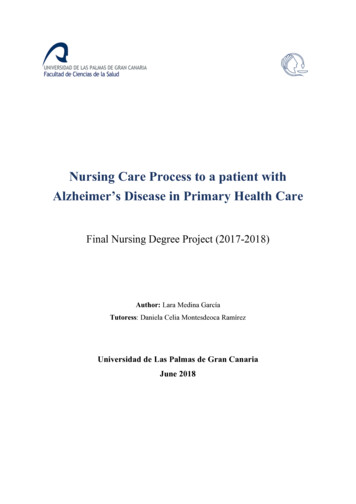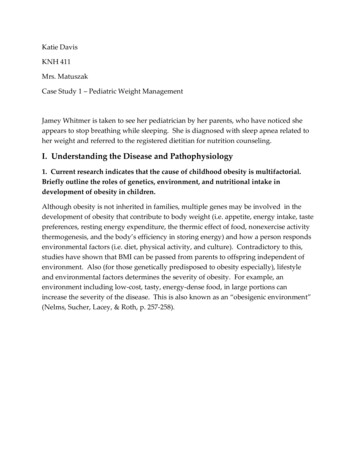
Transcription
Katie DavisKNH 411Mrs. MatuszakCase Study 1 – Pediatric Weight ManagementJamey Whitmer is taken to see her pediatrician by her parents, who have noticed sheappears to stop breathing while sleeping. She is diagnosed with sleep apnea related toher weight and referred to the registered dietitian for nutrition counseling.I. Understanding the Disease and Pathophysiology1. Current research indicates that the cause of childhood obesity is multifactorial.Briefly outline the roles of genetics, environment, and nutritional intake indevelopment of obesity in children.Although obesity is not inherited in families, multiple genes may be involved in thedevelopment of obesity that contribute to body weight (i.e. appetite, energy intake, tastepreferences, resting energy expenditure, the thermic effect of food, nonexercise activitythermogenesis, and the body’s efficiency in storing energy) and how a person respondsenvironmental factors (i.e. diet, physical activity, and culture). Contradictory to this,studies have shown that BMI can be passed from parents to offspring independent ofenvironment. Also (for those genetically predisposed to obesity especially), lifestyleand environmental factors determines the severity of obesity. For example, anenvironment including low-cost, tasty, energy-dense food, in large portions canincrease the severity of the disease. This is also known as an “obesigenic environment”(Nelms, Sucher, Lacey, & Roth, p. 257-258).
2. Describe health consequences of overweight and obesity for children.Adolescent obesity has both short- and long-term health consequences. The healthconsequences of those overweight and obesity include: Overweight and obesity as an adolescent or adult.Psychosocial difficultieso Negative self-imageo Depressiono Decreased socializationCardiovascular risk factorso Hyperlipidemiao Hypertensiono HyperinsulinemiaType 2 diabetes(Nelms, p. 255-256) and (Mahan, Excott-Stump, & Raymond, p. 402).3. Jamey has been diagnosed with sleep apnea. Define sleep apnea.Sleep apnea is a potentially serious sleep disorder in which breathing repeatedly stopsand starts and is associated with loud snoring and unrestful sleep (“Sleep apnea”).4. Explain the relationship between sleep apnea and obesity.Fat deposits around the upper airway due to excess weight in an overweight or obeseperson may obstruct breathing and cause sleep apnea (“Sleep apnea”).II. Understanding the Nutrition Therapy5. What are the goals for weight loss in the pediatric population?Goals for weight loss in the pediatric population include focusing on healthy eating andincreasing physical activity to decrease in the rate of weight gain, maintenance orweight, and only in severe cases slow, gradual weight loss. The goals for eachindividual child will be different. Also, the use of highly restrictive diets or medicationis reserved for only when other diseases are present or if there are no other options(Mahan, p. 402).
6. Under what circumstances might weight loss in overweight children not beappropriate?The only time weight loss is recommended is when the child displays comorbidconditions or has completed the adolescent growth spurt. Therefore weight loss is notappropriate for children unless they have other disease conditions present from theobesity or there are no other options (Mahan, p. 424).7. What would you recommend as the current focus for nutritional treatment ofJamey’s obesity?For the current focus for nutritional treatment of Jamey’s obesity, I would recommendgeneral nutrition education that includes consumption of 5 or more servings of fruitand vegetables per day, reducing consumption of sweetened beverages, participation in60 minutes of physical activity per day, and limiting screen time to 2 hours or less perday (Mahan, p. 424).III. Nutrition Assessment8. Evaluate Jamey’s weight using the CDC growth charts provided (p.8): What isJamey’s BMI percentile? How is her weight status classified? Use the growth chartto determine Jamey’s optimal weight for her height and age.Jamey is slightly above the 97th percentile (approximately 99th percentile) for her agebased on her BMI of 24.9. Her weight status is classified as obese due to the fact thatJamey has a BMI greater than or equal to the 95th percentile for her age and sex (Nelms,p. 243). Based on the growth chart, Jamey’s optimal weight for her height and age is 72pounds.9. Identify two methods for determining Jamey’s energy requirements other thanindirect calorimetry, and then use them to calculate Jamey’s energy requirements.1. Equation for calculation of estimated energy requirement (EER) as established bythe Institute of Medicine. This is the most accurate determination and is forfemales 9 through 18 years old.EER Total Energy Expenditure (TEE) Tissue DepositionEER 135.3 – 30.8 x age in years PA (10.0 x weight in kg 934 x height in m) 25Jaime’s EER 1682.9 kcal per day 1700 kcal per day
Jaime’s PA 1.00 sedentary2. Estimation of resting energy expenditure (REE) using a predictive equationestablished by Harris-Benedict. This is a less accurate determination and is usefor females of any age.REE 655.1 (9.6 x weight in kg) (1.9 x height in cm) – (4.7 x age in years)Jaime’s REE 1385.1 kcal per day 1400 kcal per day10. Dietary factors associated with increased risk of overweight are increased dietaryfat intake and increased calorie-dense beverages. Identify foods from Jamey’s dietrecall that fit these criteria. Breakfast burritosWhole milkCoffee CreamBolognaMayonnaiseTwinkiesFritosFried chickenButterMicrowave popcornCoca-Cola11. Calculate the percent of kcal from each macronutrient and the percent of kcalprovided by fluids for Jamey’s 24-hour recall.Calculations were carried out by using the exchange system.AM: Carbohydrate (g): 72Fat (g): 43Protein (g): 32Lunch: Carbohydrate (g): 117
Fat (g): 63Protein (g): 64After school snack: Carbohydrate (g): 63Fat (g): 29Protein (g): 32Dinner: Carbohydrate (g): 115Fat (g): 96Protein (g): 80Snack: Carbohydrate (g): 37.5Fat (g): 6Protein (g): 3Total carbohydrate: 404.5 g (4 kcal/g) 1618 kcalTotal fat: 237 g (9 kcal/g) 2133 kcalTotal protein: 211 g (4 kcal/g) 844 kcalTotal kcal 4595 kcalPercent kcal from carbohydrate: (1618 kcal / 4595 kcal) x 100 35.2 %Percent kcal from fat: (2133 kcal / 4595 kcal) x 100 46.4 %Percent kcal from protein: (844 kcal / 4595 kcal) x 100 18.4 %Percent kcal from fluids:162 g from carbohydrate (4 kcal/g) 648 kcal60 g from fat (9 kcal/g) 540 kcal28 g from protein (4 kcal/g) 112 kcalTotal kcal from fluids (1300 kcal / 4595 kcal) x 100 28.3 %
12. Increased fruit and vegetable intake is associated with decreased risk ofoverweight. What foods in Jamey’s diet fall into these categories? Fried okraMashed potatoesApple juice13. Use the ChooseMyPlate online tool to generate a customized daily food plan.Using this eating pattern, plan a 1-day menu for Jamey.www.Fitday.comAM: 2 slices of whole grain toast with 2 tbsp. strawberry jelly, 1 egg scrambled, 8 oz.low-fat milk, 8 oz. coffee with Splenda and ½ cup low-fat milkLunch: 1 turkey sandwich (3 oz. turkey, ½ cup lettuce, ½ cup tomatoes, 1 tsp.mayonnaise, 2 slices whole grain bread), 8 oz. waterAfter school snack: ¾ cup low-fat yogurt with ½ cup fresh blueberries mixed inDinner: 1 cup baked potato wedges, 3 oz. grilled chicken breast (seasoned), ½ cupsteamed broccoli, ½ cup cooked carrots (veggies mixed together and seasoned), 8 oz.diet Coca-Cola
Snack: 1/3 cup hummus with 1 oz. wheat crackers and 1 cup raw celery14. Now enter and assess the 1-day menu you planned for Jamey using the MyPlateSuperTracker online tool. Does your menu meet macro- and micronutrientrecommendations for Jamey?www.Fitday.com28 % kcal (491 kcal) from fat, 47 % kcal (817 kcal) from carbohydrate, and 25 % kcal (428kcal) from protein. This closely meets Jamey’s macro- and micronutrientrecommendations.
15. Why did Dr. Lambert order a lipid profile and blood glucose tests? What lipidand glucose levels are considered altered (i.e. outside normal limits) for the pediatricpopulation? Evaluate Jamey’s lab results.Dr. Lambert most likely ordered a lipid profile and blood glucose tests due to Jamey’s24-hour recall. Her 24-hour recall is extremely high in total fat (especially saturated fat)and simple carbohydrates (especially from fluids). In the pediatric population thatJamey is in, glucose of 70-110 mg/dL is considered normal and anything outside thatrange is considered altered. Cholesterol of 170 mg/dL or above, HDL of less than orequal to 55 mg/dL (45 mg/dL for males), a LDL of greater than or equal to 110 mg/dL, ora LDL/HDL ratio greater than or equal to 3.22 (3.55 for males) are all considered alteredlipid profile values.16. What behaviors associated with increased risk of overweight would you look forwhen assessing Jamey’s and her family’s diets? What aspects of Jamey’s lifestyleplace her at increased risk for overweight?The fact that Jamey consumes excess calories during the day and her low level ofphysical activity place her at an increased risk for overweight. Jamey and her familyneed to make lifestyle modifications in order to decrease her risk.17. You talk with Jamey and her parents, who are friendly and cooperative. Jamey’smother asks if it would help for them to not let Jamey snack between meals and toreward her with dessert when she exercises. What would you tell them?I would tell them that snacking between meals is not a problem. Snacking can actuallyhelp to prevent overeating at meals and keep the metabolism going throughout the day.As long and snacks are well balanced with other meals, snacks can be greatly beneficialand should not be forbidden. Also, I would not advise using desserts as a reward. Thiscould be confusing for Jamey because calorie-dense desserts are a contributing factor toher obesity and it is important to teach her that desserts are something that areconsumed in moderation. A better reward for Jamey’s parents to use for when shefollows her new dietary guidelines could be a non-food reward. I would suggestmaking a system where she can collect a sticker on a chart for every meal in which shefollows her restrictions. A certain number of stickers will earn her certain prizes like asmall toy or a big weekend trip to her favorite amusement park.
18. Identify one specific physical activity recommendation for Jamey.The USDA recommends 60 to 90 minutes of physical activity daily in order tostrengthen cardiovascular integrity, increase sensitivity to insulin, and expenditure ofexcess energy/calories (Mahan, p. 406). One specific recommendation for Jameyspecifically is to take 1 of the hours that she would normally be playing video gamesand spend that time playing outside with either neighborhood friends, her little sister,or her parents. I would also recommend that Jamey’s parents encourage participationin a spring club sport such as little league basketball or softball, which provides Jameywith incentive and a purpose for her increased physical activity each day. This way,she will feel that her physical activity will pay off in making her a more successfulathlete and feel better about herself when she starts a new sport.IV. Nutrition Diagnosis19. Select two nutrition problems and complete PES statements for each.1. Excessive food/beverage intake (NI-2.2) related to strong appetite and lack ofphysical activity as evidenced by large, calorie-dense meals and snacks in 24hour recall.2. Overweight/Obesity (NC-3.3) related to high energy intake and physicalinactivity as evidenced by BMI in the 99th percentile, which is greater than orequal to the 95th percentile for her age and sex.(“IDNT Reference Manual”, p.205-212)V. Nutrition Intervention20. For each PES statement written, establish an ideal goal (based on signs andsymptoms) and an appropriate intervention (based on etiology).1. Goal: Small goals will be made to slowly reduce her kcal intake to 1700 kcal/dayand increase physical activity to 60 min/day over a period of one month.Intervention: Nutrition education for Jamey and her parents on healthy eating—increasing fruit and vegetable consumption and reduction of sugar-sweetenedand high-calorie beverages and increasing physical activity to 60 minutes perday.
2. Goal: Bring BMI less than or equal to the 85th percentile (Nelms, p. 243), which isa BMI of less than 19.4 (Mahan, p.1059) as Jaime grows older into her adolescentyears.Intervention: Nutrition education on healthy eating and how to replace caloriedense foods and beverages and high fat foods with nutrient-dense, low-fat, orsugar-free alternatives and incorporation of physical activity into the dailyroutine (of the family in addition to Jaime) in order to supply Jaime’s energyneeds and keep her healthy as she grows.21. Mr. and Mrs. Whitmer ask about using over-the-counter diet aids, specificallyAlli (orlistat). What would you tell them?I would tell Jaime’s parents about the drug and how that relates to their daughter. “Alliis a drug that inhibits gastrointestinal lipase by targeting the central nervous system,which reduces about 33 % of absorption of dietary fat. Benefits include reduction ofLDL (bad cholesterol) and elevation of HDL (good cholesterol) as well as improvedglycemic control and reduction of blood pressure. Side effects include fecal ungency,oily spotting and flatus with discharge (Mahan, p.479). Due to Jaime’s young age, I donot recommend that she use this over-the-counter drug. Alli only ends up reducingabsorption of 150 to 200 kcal/day (Mahan, p.479), which is something that Jaime caneasily achieve by making changes in her current eating habits. Also, if Jaime can makechanges in her eating and lifestyle habits as a young girl without relying on amedication, these habits will stay with her throughout the rest of her life allowing her tomaintain a healthy weight and prevent chronic disease.”22. Mr. and Mrs. Whitmer ask about gastr
www.Fitday.com AM: 2 slices of whole grain toast with 2 tbsp. strawberry jelly, 1 egg scrambled, 8 oz. low-fat milk, 8 oz. coffee with Splenda and ½ cup low-fat milk Lunch: 1 turkey sandwich (3 oz. turkey, ½ cup lettuce, ½ cup tomatoes, 1 tsp. mayonnaise, 2 slices whole grain bread), 8 oz. water After school snack: ¾ cup low-fat yogurt with ½ cup fresh blueberries mixed in Dinner: 1 cup .
